Portuguese India
Sebastiao - King: 11 June 1557 - 4 August 1578
1557-78 Tin-Lead 1 Bastado
26mm, Malacca Mint
Reference: Gomes/2013: Se 31
Certification: NGC
AU DETAILS 2863704-003
Shield within shield, dots around.
S B, Monogram
on either side of three intersecting lines.
You are bidding on the exact item pictured, provided with a Certificate of Authenticity and Lifetime Guarantee of Authenticity.
 Sebastian (20 January 1554 – 4 August 1578) was King of Portugal from 11 June 1557 to 4 August 1578 and the penultimate Portuguese monarch of the House of Aviz. Sebastian (20 January 1554 – 4 August 1578) was King of Portugal from 11 June 1557 to 4 August 1578 and the penultimate Portuguese monarch of the House of Aviz.
He was the son of João Manuel, Prince of Portugal, and his wife, Joanna of Austria. He was the grandson of King John III of Portugal and Holy Roman Emperor Charles V. He disappeared (presumably killed in action) in the battle of Alcácer Quibir, against the Saadians of Morocco. Sebastian I is often referred to as The Desired (Portuguese: o Desejado) or The Asleep (Portuguese: o Adormecido), as the Portuguese people longed for his return to end the decline of Portugal that began after his death. He is considered to be the Portuguese example of the King asleep in mountain legend as Portuguese tradition states his return, in a foggy dawn, on Portugal's greatest hour of need. During Sebastian's short personal reign, he strengthened ties with the Holy Roman Empire, England and France through diplomatic efforts. He also restructured much of the administrative, judicial and military life in his kingdom. In 1568, Sebastian created scholarships to assist students who wished to study medicine or pharmacy at the University of Coimbra. That same year he rewarded Indians in Brazil who helped in the fight against the French. The chief of the Temiminós Indians, Araribóia, was given lands near the Bay of Guanabara. In 1569, Sebastian ordered Duarte Nunes de Leão to compile all the laws and legal documents of the kingdom in a collection of Leis Extravagantes known as the Código Sebastiânico (Sebastian's code). During the great plague of Lisbon in 1569, Sebastian sent for doctors from Seville to help the Portuguese doctors fight the plague. He created two hospitals in Lisbon to take care of those afflicted with the disease. In his concern for the widows and orphans of those killed by the plague, he created several Recolhimentos (shelters) known as the Recolhimento de Santa Marta (shelter of Santa Marta) and the Recolhimento dos Meninos (shelter of the children) and provided wet nurses to take care of the babies.
 The State of India (Portuguese: Estado da Índia), also referred as the Portuguese State of India (Estado Português da Índia, EPI) or simply Portuguese India (Índia Portuguesa), was a state of the Portuguese Overseas Empire, founded six years after the discovery of a sea route between Portugal and the Indian Subcontinent to serve as the governing body of a string of Portuguese fortresses and colonies overseas. The State of India (Portuguese: Estado da Índia), also referred as the Portuguese State of India (Estado Português da Índia, EPI) or simply Portuguese India (Índia Portuguesa), was a state of the Portuguese Overseas Empire, founded six years after the discovery of a sea route between Portugal and the Indian Subcontinent to serve as the governing body of a string of Portuguese fortresses and colonies overseas.
The first viceroy, Francisco de Almeida, established his headquarters in Cochin (Cochim, Kochi). Subsequent Portuguese governors were not always of viceroy rank. After 1510, the capital of the Portuguese viceroyalty was transferred to Goa.[1] Until the 18th century, the Portuguese governor in Goa had authority over all Portuguese possessions in the Indian Ocean, from southern Africa to southeast Asia. In 1752 Mozambique got its own separate government and in 1844 the Portuguese Government of India stopped administering the territory of Macau, Solor and Timor, and its authority was confined to the colonial holdings on the Malabar coast of present-day India. .svg/85px-Coat_of_arms_of_Portuguese_India_(1951-1974).svg.png) At the time of the British Indian Empire's dissolution in 1947, Portuguese India was subdivided into three districts located on modern-day India's western coast, sometimes referred to collectively as Goa: namely Goa; Daman (Portuguese: Damão), which included the inland enclaves of Dadra and Nagar Haveli; and Diu. Portugal lost effective control of the enclaves of Dadra and Nagar Haveli in 1954, and finally the rest of the overseas territory in December 1961, when it was taken by India after military action. In spite of this, Portugal only recognised Indian control in 1975, after the Carnation Revolution and the fall of the Estado Novo regime. At the time of the British Indian Empire's dissolution in 1947, Portuguese India was subdivided into three districts located on modern-day India's western coast, sometimes referred to collectively as Goa: namely Goa; Daman (Portuguese: Damão), which included the inland enclaves of Dadra and Nagar Haveli; and Diu. Portugal lost effective control of the enclaves of Dadra and Nagar Haveli in 1954, and finally the rest of the overseas territory in December 1961, when it was taken by India after military action. In spite of this, Portugal only recognised Indian control in 1975, after the Carnation Revolution and the fall of the Estado Novo regime.
In the year 1509, Afonso de Albuquerque was appointed the second governor of the Portuguese possessions in the East. A new fleet under Marshal Fernão Coutinho arrived with specific instructions to destroy the power of Zamorin's of Calicut. The Zamorin's palace was captured and destroyed and the city was set on fire. The king's forces rallied to kill Coutinho and wound Albuquerque. Albuquerque relented, and entered into a treaty with the Zamorin in 1513 to protect Portuguese interests in Malabar. Hostilities were renewed when the Portuguese attempted to assassinate the Zamorin sometime between 1515 and 1518. In 1510, Afonso de Albuquerque defeated the Bijapur sultans with the help of Timayya, on behalf of the Hindu Vijayanagara Empire, leading to the establishment of a permanent settlement in Velha Goa (or Old Goa). The Southern Province, also known simply as Goa, was the headquarters of Portuguese India, and seat of the Portuguese viceroy who governed the Portuguese possessions in Asia.  There were Portuguese settlements in and around Mylapore. The Luz Church in Mylapore, Madras (Chennai) was the first church that the Portuguese built in Madras in 1516. Later in 1522, the São Tomé church was built by the Portuguese. They had also looted the treasures and destroyed the original Kapaleeswarar Temple. There were Portuguese settlements in and around Mylapore. The Luz Church in Mylapore, Madras (Chennai) was the first church that the Portuguese built in Madras in 1516. Later in 1522, the São Tomé church was built by the Portuguese. They had also looted the treasures and destroyed the original Kapaleeswarar Temple.
The Portuguese acquired several territories from the Sultans of Gujarat: Daman (occupied 1531, formally ceded 1539); Salsette, Bombay, and Baçaim (occupied 1534); and Diu (ceded 1535). These possessions became the Northern Province of Portuguese India, which extended almost 100 km along the coast from Daman to Chaul, and in places 30-50 km inland. The province was ruled from the fortress-town of Baçaim. In 1526, under the viceroyship of Lopo Vaz de Sampaio, the Portuguese took possession of Mangalore. The territory included parts of Dakshina Kannada and Udupi in Karnataka state, and Kasaragod in Kerala state (South Canara). Mangalore was named the islands of O Padrão de Santa Maria; later came to be known as St. Mary's Islands. In 1640, the Keladi Nayaka Kingdom defeated the Portuguese. Shivappa Nayaka destroyed the Portuguese political power in the Kanara region by capturing all the Portuguese forts of the coastal region. Bombay (present-day Mumbai) was given to Britain in 1661 as part of the Portuguese Princess Catherine of Braganza's dowry to Charles II of England. Most of the Northern Province was lost to the Marathas of the Maratha Empire in 1739 when the Maratha General Chimnaji Appa defeated the Portuguese. Later Portugal acquired Dadra and Nagar Haveli in 1779. Goa was briefly occupied by the British from 1799 to 1813. In 1843 the capital was shifted to Panjim, then renamed Nova Goa, when it officially became the administrative seat of Portuguese India, replacing the city of Velha Goa (now Old Goa), although the Viceroys lived there already since 1 December 1759. Before moving to the city, the viceroy remodelled the fortress of Adil khan, transforming it into a palace. The Portuguese also shipped over many Órfãs d'El-Rei to Portuguese colonies in the Indian peninsula, Goa in particular. Órfãs d'El-Rei literally translates to Orphans of the King, and they were Portuguese girl orphans sent to overseas colonies to marry either Portuguese settlers or natives with high status. Thus there are Portuguese footprints all over the western and eastern coasts of the Indian peninsula, though Goa became the capital of Portuguese Goa from 1530 onward until the annexation of Goa proper and the entire Estado da Índia Portuguesa, and its merger with the Indian Union in 1961.
 The aim of Portugal in the Indian Ocean was to ensure the monopoly of the spice trade. Taking advantage of the rivalries that pitted Hindus against Muslims, the Portuguese established several forts and trading posts between 1500 and 1510. In East Africa, small Islamic states along the coast of Mozambique, Kilwa, Brava, Sofala and Mombasa were destroyed, or became either subjects or allies of Portugal. Pêro da Covilhã had reached Ethiopia, traveling secretly overland, as early as 1490; a diplomatic mission reached the ruler of that nation on October 19, 1520. The aim of Portugal in the Indian Ocean was to ensure the monopoly of the spice trade. Taking advantage of the rivalries that pitted Hindus against Muslims, the Portuguese established several forts and trading posts between 1500 and 1510. In East Africa, small Islamic states along the coast of Mozambique, Kilwa, Brava, Sofala and Mombasa were destroyed, or became either subjects or allies of Portugal. Pêro da Covilhã had reached Ethiopia, traveling secretly overland, as early as 1490; a diplomatic mission reached the ruler of that nation on October 19, 1520.
In 1500 the second fleet to India who came to discover Brazil explored the East African coast, where Diogo Dias discovered the island that he named St. Lawrence, later known as Madagascar. This fleet, commanded by Pedro Álvares Cabral, arrived at Calicut in September, where the first trade agreement in India was signed. For a short time a Portuguese factory was installed there, but was attacked by Muslims on December 16 and several Portuguese, including the scribe Pêro Vaz de Caminha, died. After bombarding Calicut as a retaliation, Cabral went to rival Kochi. Profiting from the rivalry between the Maharaja of Kochi and the Zamorin of Calicut, the Portuguese were well received and seen as allies, getting a permit to build a fort (Fort Manuel) and a trading post that were the first European settlement in India. There in 1503 they built the St. Francis Church. In 1502 Vasco da Gama took the island of Kilwa on the coast of Tanzania, where in 1505 the first fort of Portuguese East Africa was built to protect ships from the East Indian trade. In 1505 king Manuel I of Portugal appointed Francisco de Almeida first Viceroy of Portuguese India for a three-year period, starting the Portuguese government in the east, headquartered at Kochi. That year the Portuguese conquered Kannur where they founded St. Angelo Fort. Lourenço de Almeida arrived in Ceylon (modern Sri Lanka), where he discovered the source of cinnamon. Finding it divided into seven rival kingdoms, he established a defense pact with the kingdom of Kotte and extended the control in coastal areas, where in 1517 was founded the fortress of Colombo. In 1506 a Portuguese fleet under the command of Tristão da Cunha and Afonso de Albuquerque, conquered Socotra at the entrance of the Red Sea and Muscat in 1507, having failed to conquer Ormuz, following a strategy intended to close the entrances to the Indian Ocean. That same year were built fortresses in the Island of Mozambique and Mombasa on the Kenyan coast. Madagascar was partly explored by Tristão da Cunha and in the same year Mauritius was discovered. In 1509, the Portuguese won the sea Battle of Diu against the combined forces of the Ottoman Sultan Beyazid II, Sultan of Gujarat, Mamlûk Sultan of Cairo, Samoothiri Raja of Kozhikode, Venetian Republic, and Ragusan Republic (Dubrovnik). The Portuguese victory was critical for its strategy of control of the Indian Sea: Turks and Egyptians withdraw their navies from India, leaving the seas to the Portuguese, setting its trade dominance for almost a century, and greatly assisting the growth of the Portuguese Empire. It marked also the beginning of the European colonial dominance in the Asia. A second Battle of Diu in 1538 finally ended Ottoman ambitions in India and confirmed Portuguese hegemony in the Indian Ocean. Under the government of Albuquerque, Goa was taken from the Bijapur sultanate in 1510 with the help of Hindu privateer Timoji. Coveted for being the best port in the region, mainly for the commerce of Arabian horses for the Deccan sultanates, it allowed to move on from the initial guest stay in Cochin. Despite constant attacks, Goa became the seat of the Portuguese government, under the name of Estado da India (State of India), with the conquest triggering compliance of neighbour kingdoms: Gujarat and Calicut sent embassies, offering alliances and grants to fortify. Albuquerque began that year in Goa the first Portuguese mint in India, taking the opportunity to announce the achievement.
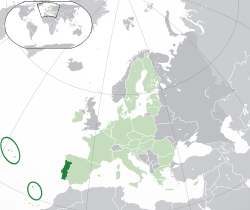  Portugal, officially the Portuguese Republic (Portuguese: República Portuguesa), is a country on the Iberian Peninsula, in Southwestern Europe. It is the westernmost country of mainland Europe, being bordered by the Atlantic Ocean to the west and south and by Spain to the north and east. The Portugal-Spain border is 1,214 km (754 mi) long and considered the longest uninterrupted border within the European Union. The republic also includes the Atlantic archipelagos of the Azores and Madeira, both autonomous regions with their own regional governments. Portugal, officially the Portuguese Republic (Portuguese: República Portuguesa), is a country on the Iberian Peninsula, in Southwestern Europe. It is the westernmost country of mainland Europe, being bordered by the Atlantic Ocean to the west and south and by Spain to the north and east. The Portugal-Spain border is 1,214 km (754 mi) long and considered the longest uninterrupted border within the European Union. The republic also includes the Atlantic archipelagos of the Azores and Madeira, both autonomous regions with their own regional governments.
 The territory of modern Portugal has been continuously settled, invaded and fought over since prehistoric times. The Pre-Celts, Celts, Phoenicians, Carthaginians and the Romans were followed by the invasions of the Visigothic and the Suebi Germanic peoples, who were themselves later invaded by the Moors. These Muslim peoples were eventually expelled during the Christian Reconquista. Portuguese nationality can be traced back to the creation of the First County of Portugal, in 868. In 1139, Afonso Henriques was proclaimed King of Portugal, thus firmly establishing Portuguese independence, under the Portuguese House of Burgundy. The territory of modern Portugal has been continuously settled, invaded and fought over since prehistoric times. The Pre-Celts, Celts, Phoenicians, Carthaginians and the Romans were followed by the invasions of the Visigothic and the Suebi Germanic peoples, who were themselves later invaded by the Moors. These Muslim peoples were eventually expelled during the Christian Reconquista. Portuguese nationality can be traced back to the creation of the First County of Portugal, in 868. In 1139, Afonso Henriques was proclaimed King of Portugal, thus firmly establishing Portuguese independence, under the Portuguese House of Burgundy.
In the 15th and 16th centuries, under the House of Aviz, which took power following the 1383-85 Crisis, Portugal expanded Western influence and established the first global empire, becoming one of the world's major economic, political and military powers. During this time, Portuguese explorers pioneered maritime exploration in the Age of Discovery, notably under royal patronage of Prince Henry the Navigator and King João II, with such notable discoveries as Vasco da Gama's sea route to India (1497-98), Pedro Álvares Cabral's discovery of Brazil (1500), and Bartolomeu Dias's reaching of the Cape of Good Hope. Portugal monopolized the spice trade during this time, under royal command of the Casa da Índia, and the Portuguese Empire expanded with military campaigns led in Asia, notably under Afonso de Albuquerque, who was known as the "Caesar of the East". The destruction of Lisbon in a 1755 earthquake, the country's occupation during the Napoleonic Wars, the independence of Brazil (1822), and the Liberal Wars (1828-1834), all left Portugal crippled from war and diminished in its world power. After the 1910 revolution deposed the monarchy, the democratic but unstable Portuguese First Republic was established, later being superseded by the "Estado Novo" right-wing authoritarian regime. Democracy was restored after the Portuguese Colonial War and the Carnation Revolution in 1974. Shortly after, independence was granted to all its colonies and East Timor, with the exception of Macau, which was handed over to China in 1999. This marked the end of the longest-lived European colonial empire, leaving a profound cultural and architectural influence across the globe and a legacy of over 250 million Portuguese speakers today. Portugal is a developed country with a high-income advanced economy and high living standards. It is the 5th most peaceful country in the world, maintaining a unitary semi-presidential republican form of government. It has the 18th highest Social Progress in the world, putting it ahead of other Western European countries like France, Spain and Italy. It is a member of numerous international organizations, including the United Nations, the European Union, the eurozone, OECD, NATO and the Community of Portuguese Language Countries. Portugal is also known for having decriminalized the usage of all common drugs in 2001, the first country in the world to do so. However, the sale and distribution of these drugs is still illegal in Portugal.
|
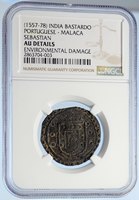
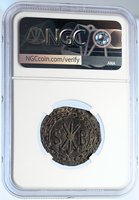
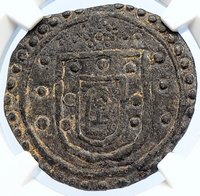
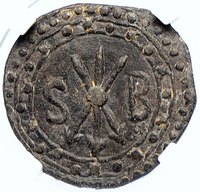
 Sebastian (20 January 1554 – 4 August 1578) was King of Portugal from 11 June 1557 to 4 August 1578 and the penultimate Portuguese monarch of the House of Aviz.
Sebastian (20 January 1554 – 4 August 1578) was King of Portugal from 11 June 1557 to 4 August 1578 and the penultimate Portuguese monarch of the House of Aviz. The State of India (Portuguese: Estado da Índia), also referred as the Portuguese State of India (Estado Português da Índia, EPI) or simply Portuguese India (Índia Portuguesa), was a state of the Portuguese Overseas Empire, founded six years after the discovery of a sea route between Portugal and the Indian Subcontinent to serve as the governing body of a string of Portuguese fortresses and colonies overseas.
The State of India (Portuguese: Estado da Índia), also referred as the Portuguese State of India (Estado Português da Índia, EPI) or simply Portuguese India (Índia Portuguesa), was a state of the Portuguese Overseas Empire, founded six years after the discovery of a sea route between Portugal and the Indian Subcontinent to serve as the governing body of a string of Portuguese fortresses and colonies overseas. .svg/85px-Coat_of_arms_of_Portuguese_India_(1951-1974).svg.png) At the time of the British Indian Empire's dissolution in 1947, Portuguese India was subdivided into three districts located on modern-day India's western coast, sometimes referred to collectively as Goa: namely Goa; Daman (Portuguese: Damão), which included the inland enclaves of Dadra and Nagar Haveli; and Diu. Portugal lost effective control of the enclaves of Dadra and Nagar Haveli in 1954, and finally the rest of the overseas territory in December 1961, when it was taken by India after military action. In spite of this, Portugal only recognised Indian control in 1975, after the Carnation Revolution and the fall of the Estado Novo regime.
At the time of the British Indian Empire's dissolution in 1947, Portuguese India was subdivided into three districts located on modern-day India's western coast, sometimes referred to collectively as Goa: namely Goa; Daman (Portuguese: Damão), which included the inland enclaves of Dadra and Nagar Haveli; and Diu. Portugal lost effective control of the enclaves of Dadra and Nagar Haveli in 1954, and finally the rest of the overseas territory in December 1961, when it was taken by India after military action. In spite of this, Portugal only recognised Indian control in 1975, after the Carnation Revolution and the fall of the Estado Novo regime.  There were Portuguese settlements in and around Mylapore. The Luz Church in Mylapore, Madras (Chennai) was the first church that the Portuguese built in Madras in 1516. Later in 1522, the São Tomé church was built by the Portuguese. They had also looted the treasures and destroyed the original Kapaleeswarar Temple.
There were Portuguese settlements in and around Mylapore. The Luz Church in Mylapore, Madras (Chennai) was the first church that the Portuguese built in Madras in 1516. Later in 1522, the São Tomé church was built by the Portuguese. They had also looted the treasures and destroyed the original Kapaleeswarar Temple.  The aim of Portugal in the Indian Ocean was to ensure the monopoly of the spice trade. Taking advantage of the rivalries that pitted Hindus against Muslims, the Portuguese established several forts and trading posts between 1500 and 1510. In East Africa, small Islamic states along the coast of Mozambique, Kilwa, Brava, Sofala and Mombasa were destroyed, or became either subjects or allies of Portugal. Pêro da Covilhã had reached Ethiopia, traveling secretly overland, as early as 1490; a diplomatic mission reached the ruler of that nation on October 19, 1520.
The aim of Portugal in the Indian Ocean was to ensure the monopoly of the spice trade. Taking advantage of the rivalries that pitted Hindus against Muslims, the Portuguese established several forts and trading posts between 1500 and 1510. In East Africa, small Islamic states along the coast of Mozambique, Kilwa, Brava, Sofala and Mombasa were destroyed, or became either subjects or allies of Portugal. Pêro da Covilhã had reached Ethiopia, traveling secretly overland, as early as 1490; a diplomatic mission reached the ruler of that nation on October 19, 1520. 
 The territory of modern Portugal has been continuously settled, invaded and fought over since prehistoric times. The Pre-Celts, Celts, Phoenicians, Carthaginians and the Romans were followed by the invasions of the Visigothic and the Suebi Germanic peoples, who were themselves later invaded by the Moors. These Muslim peoples were eventually expelled during the Christian Reconquista. Portuguese nationality can be traced back to the creation of the First County of Portugal, in 868. In 1139, Afonso Henriques was proclaimed King of Portugal, thus firmly establishing Portuguese independence, under the Portuguese House of Burgundy.
The territory of modern Portugal has been continuously settled, invaded and fought over since prehistoric times. The Pre-Celts, Celts, Phoenicians, Carthaginians and the Romans were followed by the invasions of the Visigothic and the Suebi Germanic peoples, who were themselves later invaded by the Moors. These Muslim peoples were eventually expelled during the Christian Reconquista. Portuguese nationality can be traced back to the creation of the First County of Portugal, in 868. In 1139, Afonso Henriques was proclaimed King of Portugal, thus firmly establishing Portuguese independence, under the Portuguese House of Burgundy.
